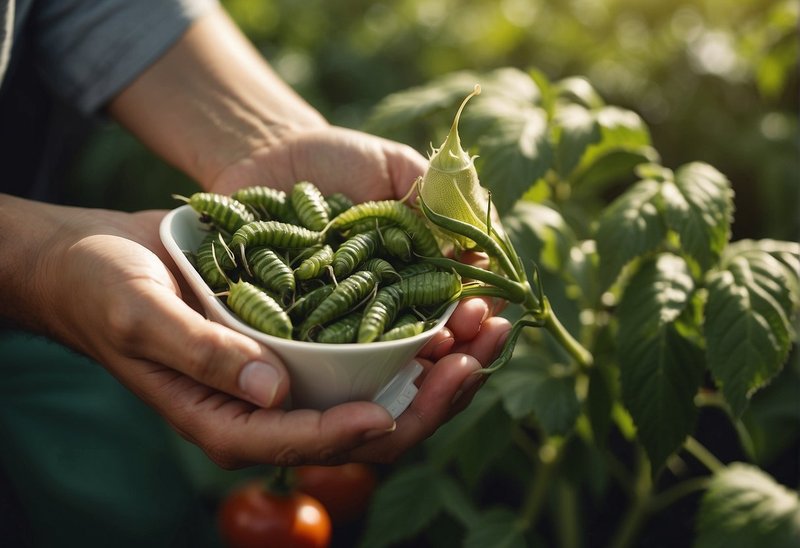
When you’re deep into your container gardening journey, these little guys can pop up unexpectedly. Hornworms are the larvae of moths, and while they’re known for their voracious appetite and tendency to munch on your beloved plants, they also have the potential to enrich your soil. Let’s dive into how you can manage hornworms in your container gardening setup and turn them from a nuisance into an opportunity.
What Are Hornworms, Anyway?
Hornworms are the caterpillar stage of sphinx moths and can vary in color, ranging from bright green to a more subtle brown. They are famous for their horn-like appendage on their rear, which is where they get their name. These “little beasts” can grow quite large, often reaching lengths of up to 4 inches. They primarily feed on nightshade plants, like tomatoes, peppers, and eggplants.
Now, you might be wondering why you should care about these creatures. Well, hornworms can potentially do significant damage to your plants—if left unchecked. However, they also break down organic material and contribute to the nutrient cycle, making them a unique part of the gardening ecosystem. Think of them as a double-edged sword; understanding how to handle them is crucial.
Signs of Hornworm Infestation
Detecting a hornworm infestation can be tricky. Here’s the thing: they’re excellent at camouflaging themselves among the leaves. So how do you know if you have them? Here’s what to look for:
- Chewed Leaves: The most obvious sign is damaged foliage. If your leaves look like they’ve been chewed on, take a closer look.
- Droppings: You might notice small dark green or black pellets near the base of your plants—these are hornworm droppings.
- Presence of Moths: If you see large moths flying around, it might be time to check for their larvae on your plants.
If you spot any of these signs, it’s time to take action. Remember, early detection can save your plants from significant damage!
How to Manage Hornworms in Container Gardens
Managing hornworms doesn’t mean you have to resort to harsh chemicals. Honestly, there are several effective and environmentally friendly methods you can try. Here are a few tips:
1. **Manual Removal:** This might sound daunting, but going out to handpick the hornworms can be surprisingly satisfying. Just wear gloves and inspect your plants closely, looking for those well-camouflaged caterpillars. If you find one, simply pluck it off and relocate it to another area, like a wild patch far from your garden.
2. **Beneficial Insects:** You can invite natural predators into your garden. Ladybugs, lacewings, and parasitic wasps love to feast on hornworms. You can attract them by planting flowers, herbs, or other plants they like.
3. **Neem Oil:** This natural insecticide can disrupt the feeding habits of hornworms and even deter them from laying eggs. Mix a small amount with water and spray it onto affected plants.
4. **Organic Solutions:** There are various organic pesticides available that are effective against hornworms. Just make sure to read the labels and ensure they’re safe for your container plants.
Preventing Future Infestations
Once you have taken care of a hornworm problem, you’ll want to prevent further infestations. Here’s how you can outsmart these little munchers:
- Healthy Soil: Start by ensuring your plants are healthy. Strong, well-fed plants are less likely to attract pests.
- Crop Rotation: Change the location of your plants each season to help disrupt the hornworm lifecycle.
- Regular Monitoring: Make it a habit to routinely check your plants. Early intervention is key to preventing infestations.
By staying vigilant and proactive, you can keep your container garden thriving.
What If Hornworms Become a Major Problem?
Sometimes, despite your best efforts, hornworms can become overwhelming. If you find yourself in a situation where you’re facing a heavy infestation, it might be time to consider more drastic measures:
– **Insecticidal Soap:** If manual removal and organic solutions aren’t cutting it, insecticidal soap can be a last resort. It’s effective against soft-bodied insects like hornworms. Just be cautious using it on flowering plants.
– **Traps:** You might want to set up traps. Pheromone traps can catch male moths, reducing future hornworm populations.
While it’s essential to manage your plants’ health, sometimes taking a step back and considering the bigger picture is necessary.
Dealing with hornworms in your container garden can feel frustrating at times, but remember, you’re not alone. Many gardeners face similar challenges, and tackling these little pests can lead to a more robust understanding of your plants and their needs. By implementing a mix of manual removal, natural predators, and organic solutions, you can turn potential problems into opportunities for growth.
So, the next time you spot a hornworm, think of it not just as a pest, but as part of the intricate dance of nature right in your backyard. With the right approach, you can manage them effectively and keep your container garden flourishing. Happy gardening!

